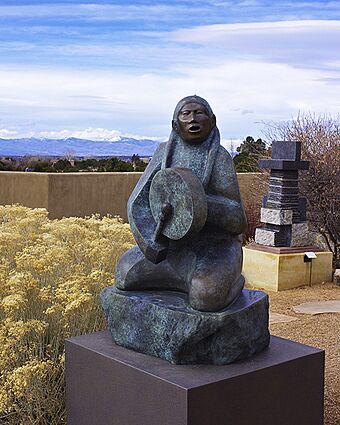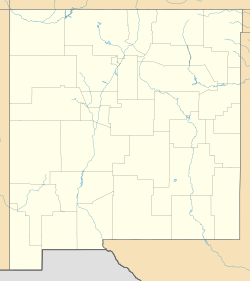Wheelwright Museum of the American Indian facts for kids
|
Wheelwright Museum of the American Indian
|
|

Drumming Up The Mountain Spirits
|
|
| Location | 704 Camino Lejo, Santa Fe, New Mexico |
|---|---|
| Area | less than one acre |
| Architect | William Penhallow Henderson |
| Architectural style | Navajo Ceremonial hooghan |
| NRHP reference No. | 90001917 |
Quick facts for kids Significant dates |
|
| Added to NRHP | December 18, 1990 |
The Wheelwright Museum of the American Indian is a special museum in Santa Fe, New Mexico. It shows amazing art and culture from Native American people. It was started in 1937 by Mary Cabot Wheelwright from Boston and Hastiin Klah, a wise Navajo singer and healer.
Contents
Discovering Native American Art
How the Museum Began
Mary Cabot Wheelwright and Hastiin Klah met in 1921. They quickly became good friends. They both wanted to save important stories and traditions from the Navajo people. Klah shared many stories, like the Navajo Creation Story, and Wheelwright wrote them down. These stories are a big part of the Navajo religion.
While Wheelwright focused on the spoken stories, another person named Frances Newcomb worked on sandpaintings. These are beautiful, detailed pictures made from sand during healing ceremonies. They are usually destroyed after the ceremony. Newcomb made lasting copies of these sandpaintings using paint on paper. Klah also helped by weaving huge tapestries that showed these sandpainting designs.
Building a Special Place
By the early 1930s, Wheelwright and Klah knew they needed a museum. It would be a place to keep sound recordings, writings, paintings, and sandpainting tapestries. More importantly, it would help people understand the beauty and deep meaning of Navajo religion.
They chose William Penhallow Henderson as their architect. He designed the museum to look like a hooghan (pronounced HO-gan). A hooghan is a traditional Navajo home and a place where Navajo ceremonies happen. Klah blessed the land where the museum was built. Sadly, he passed away a few months before it was finished.
In November 1937, a traditional Navajo house blessing was held. Many of Klah's family members attended. The museum was first called the Navajo House of Prayer or the House of Navajo Religion. Soon after it opened, its official name became the Museum of Navajo Ceremonial Art.
Changes and New Focus
In the 1960s and 1970s, the Navajo Nation became more independent. They started their own college system. Navajo singers also created the Navajo Medicine Men's Association. People became more interested in traditional Navajo religion. They felt that only Navajo people should teach about their religion.
Because of this, in 1977, the museum gave back several Navajo medicine bundles and other items to the Navajo people. This act of returning items is called "repatriation."
After this, the museum changed its name to the Wheelwright Museum of the American Indian. It no longer focuses on teaching Navajo religion. Instead, it has amazing collections of Navajo art and culture from 1850 to today. The museum also shows new exhibits on traditional and modern Navajo art, as well as art from other Native American groups.
See also



